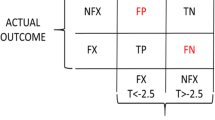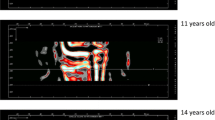Abstract:
This study investigated whether tibial speed of sound (SOS; SoundScan 2000, Myriad Ultrasound Systems, Israel) reflects not only bone mineral density (BMD) but also tibial cortical thickness, as assessed by dual-energy X-ray absorptiometry (DXA) and Quantitative CT (QCT) at a site-matched location. The secondary focus of the study was how tibial SOS compares with BMD at the spine and the hip, the most widely used locations for densitometry. Twenty-two young normal (N) and 23 postmenopausal women with spinal fractures (Fx) (mean (SD) age 35 (8) and 70 (5) years) underwent quantitative ultrasound (QUS) SOS measurement at the left tibial midshaft. From site-matched QCT scans (three 3-mm slices spaced along the QUS measurement region), BMD and cortical thickness were computed (QCT-cBMD, QCT-cTh). The cortex in the CT images was then subdivided into three concentric and equally spaced bands, and QCT-cBMD was computed separately for each band. DXA was performed at the mid-tibia (TIB BMD), at the spine (SPINE BMD) and the hip (total hip, HIP BMD). Correlation coefficients between parameters were determined with least-square linear fits. Intergroup differences were assessed by analysis of covariance, whose r 2 value reflects the percentage variation in the data explained by group assignment. SOS correlated significantly with site-matched parameters (QCT-cBMD, QCT-cTh and TIB BMD, all r= 0.6, p < 0.001), SPINE BMD and HIP BMD (both r= 0.5, p < 0.001). Multiple regression with both QCT-cBMD and QCT-cTh against SOS yielded r= 0.7 with both parameters contributing significantly. For the cortex band subdivision, SOS correlated better with QCT-cBMD in the outermost band of the cortex (r= 0.67) than with the more central bands (r= 0.59 and r= 0.53). Group assignment could best explain SPINE BMD (r 2= 0.62) and HIP BMD (r 2= 0.51). SOS was comparable to TIB BMD (r 2= 0.3 vs. r 2= 0.35).: Our findings suggest that the tibial SOS measurement depends on both the thickness and density of the tibia, but is more strongly influenced by the density of the cortex near the surface than by its interior parts. The power of tibial ultrasound to discriminate between normal and fracture patients was less than that of spinal and femoral DXA BMD and comparable to site-matched DXA BMD.
Similar content being viewed by others
Author information
Authors and Affiliations
Additional information
Received: 25 February 2000 / Accepted: 5 July 2000
Rights and permissions
About this article
Cite this article
Prevrhal, S., Fuerst, T., Fan, B. et al. Quantitative Ultrasound of the Tibia Depends on Both Cortical Density and Thickness . Osteoporos Int 12, 28–34 (2001). https://doi.org/10.1007/s001980170154
Issue Date:
DOI: https://doi.org/10.1007/s001980170154




